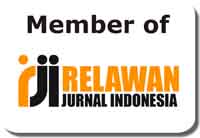Construction and Semantics of Idioms with Colors in Mu'jam at-Ta'bir al-Ishthilahi fi al-Arabiyat al-Mu’ashirah
Abstract
This study presents information about the meaning of connotations, grammatical construction, and semantic categories of color idioms in Arabic. Through library research, the main data source is Mu'jam at-Ta'bir al-Ishthilahi. Data collection techniques are reading techniques and note-taking techniques. The determining element sorting technique is used to analyze the data. The results of this study show that white and black are the dominant elements in forming Arabic idioms, followed by yellow, green, and red. White color is dominated by positive connotations, although there are uses with negative and neutral connotations. In contrast, black is dominated by negative connotations, and there is one data with positive and neutral connotations. The colors yellow and green only have negative connotations. Meanwhile, red has both positive and negative connotations. There are full and partial idioms in terms of the meaning of the forming elements. In terms of grammatical construction, there are three categories: First, N + Adj. The colors in this construction are all attribute elements. Second: Intransitive verb + N, which is one case. Third: V + Preposition 'ala + Adjective, which is one case. Fourth: Verb + preposition + Adjective + conjunction + adjective, which is one case. The implication is that color symbolization is closely related to people’s perceptions. In Arab society, giving connotations to black is more dominant as a negative or white as a positive symbol. However, color connotations are not closed. The connotation of a particular color is closely related to the language user's perception of the object.
Keywords
Full Text:
PDFReferences
Achint Kaur. (2020). A Link Between Colors and Emotions; A Study of Undergraduate Females. International Journal of Engineering Research And, V9 (09), 553–557. https://doi.org/10.17577/ijertv9is090319
Aizharykovna, B. G. (2023). Some Ways of Translating English Colour Idioms Into Karkalpak Language. Quality of Teacher Education Under Modern Challenges, 1(1), 427–430. https://uzresearchers.com/index.php/IFTE23/article/view/329/289
Alotaibi, W. J. (2020). European Journal of English Language Teaching Colour Idioms in English and Arabic: European Journal of English Language Teaching, 5 (2), 97–109. https://doi.org/10.5281/zenodo.3733839
Atstsa’alabi, A. M. A. M. bin M. (2009). Fiqh al-Lugah wa Asrar al-Arabiyah (Y. Murad (ed.); 1st ed.). Muassasat al-Mukhtar.
Cacciari, C., & Tabossi, P. (2014). Idioms: Processing, Structure, and Interpretation. Taylor & Francis. https://books.google.co.id/books?id=RgrsAgAAQBAJ
Chen, V., & Yan Khiong, B. (2023). Analisis Perbandingan Makna Warna Merah Dalam Peribahasa Indonesia Dan Peribahasa Mandarin. Khatulistiwa, 12 (2), 506–514. https://doi.org/10.26418/jppk.v12i2.62396
Hajar, S., & Purniawati, H. (2020). Idiom Bahasa Dawan Dialek Amanuban di Kabupaten Timor Tengah Selatan. Deiksis, 12(03), 280–295. https://doi.org/10.30998/deiksis.v12i03.5195
Haq, M. Z. (2020). Translation of Idioms from Arabic Into Malay Via Google translate: What Needs to be Done? GEMA Online Journal of Language Studies, 20(3), 156–180. https://doi.org/10.17576/gema-2020-2003-10
Haq, M. Z. (2022). Arabic Idiomatic Translation Problems To Indonesian Problematika Penerjemahan Idiomatik Arab Ke Indonesia. MUHIBBUL ARABIYAH: Jurnal Pendidikan Bahasa Arab, 2 (1), 15–30. https://doi.org/10.35719/pba.v2i1.32
Hieu, H. N., Eriyanti, R. W., & Iswatiningsih, D. (2022). Perbandingan Idiom yang Berunsur Bagian Tubuh Manusia Pada Bahasa Vietnam dan Indonesia (Comparison of Idioms with Human Body Parts in Vietnamese and Indonesian). Indonesian Language Education and Literature, 8 (1), 114–132. https://doi.org/10.24235/ileal.v8i1.10179
Jürg Strässler. (1982). Idioms in English: A Pragmatic Analysis. Zeeb-Druk. https://books.google.co.id/books?id=phQ9Fyx1lPsC&printsec=frontcover&hl=id#v=onepage&q&f=false
Kawai, C., Zhang, Y., Lukács, G., Chu, W., Zheng, C., Gao, C., Gozli, D., Wang, Y., & Ansorge, U. (2023). The good, the bad, and the red: implicit color-valence associations across cultures. Psychological Research, 87 (3), 704–724. https://doi.org/10.1007/s00426-022-01697-5
Khory Aik Kumala Dewi. (2018). Perbandingan Makna Idiom Bahasa Jepang dan Bahasa Indonesia yang Mengandung Unsur Warna dalam Koran Online Asahi Shimbun「朝日新聞」dan Kompas. Jurnal Ilmu Mahasiswa HIKARI, 6 (2), 1–11. https://ejournal.unesa.ac.id/index.php/hikari/article/view/26444
Khudoyberdievna, S. Z. (2022). Definition of Idioms In Modern Phraseology. Development of A Modern Education System and Creative Ideas for it, Republican Scientific-Practical On-Line Conference on "Suggestions and Solutions, 16–19. http://journal.buxdu.uz/index.php/journals_buxdu/article/download/8930/5781
Mahsun. (2017). Metode Penelitian Bahasa. In Fakultas Adab dan Humaniora UIN Sunan Ampel Surabaya (2nd ed.). Rajawali Press.
Makkai, A. (1972). Idiom Sctructure in English. The Hague-Paris, Mouton.
Nurcholisho, L. R. (2017). Fleksibilitas Bahasa Arab dalam Membentuk Ungkapan Idiom. Lisanan Arabiya, I(2), 139–155. https://doi.org/https://doi.org/10.32699/liar.v1i02.203
Pusat Bahasa. (2008). Kamus Bahasa Indonesia (1 (ed.); 1st ed.). Departemen Pendidikan Nasional.
Soriano, C., & Valenzuela, J. (2009). Emotion and colour across languages: Implicit associations in Spanish colour terms. Social Science Information, 48(3), 421–445. https://doi.org/10.1177/0539018409106199
Sugiarti. (2020). Desain Penelitian Kualitatif (1st ed.). Universitas Muhammadiyah Malang.
Yakovleva, S. L., Fliginskikh, E. E., Kazyro, G. N., Pershina, M. A., & Soldatkina, T. A. (2015). The category of colour naming in English, German and Mari idioms. Mediterranean Journal of Social Sciences, 6(3), 33–40. https://doi.org/10.5901/mjss.2015.v6n3s7p33
Zaim, M. (2014). Metode Penelitian Bahasa: Pendekatan Struktural. FBS UNP Press.
DOI: http://dx.doi.org/10.31332/lkw.v0i0.7368
Copyright (c) 2024 Damhuri Damhuri, Ratni Bt. Hj. Bahri, Satriana Mokodongan

This work is licensed under a Creative Commons Attribution-ShareAlike 4.0 International License.
Langkawi: Journal of The Association for Arabic and English indexed by:



















.png)
.png)

.png)
2.png)








